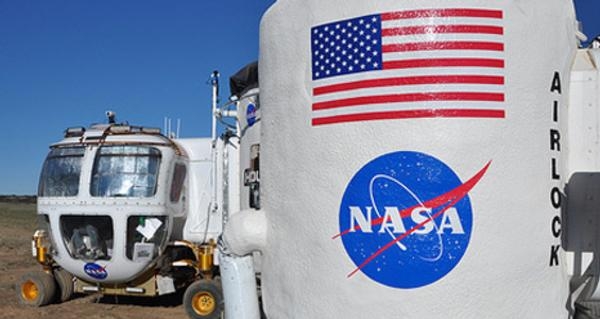Mon, Aug 08, 2011
Desert To Simulate An Asteroid Environment In Upcoming
Exercises
NASA is once again taking human space exploration to the Arizona
desert in tests to simulate conditions on other worlds. This year,
for the first time, the desolate desert landscape will stand in for
an asteroid. Visiting an asteroid presents NASA with challenges the
agency is only beginning to tackle. Among them are how to travel
between sites of interest on an asteroid's surface and how to
conduct spacewalks in its microgravity.

For the past 14 years, teams of engineers, scientists,
astronauts and technicians from across NASA centers and throughout
industry and academia have simulated missions to distant
destinations to answer questions about future exploration.
Desert RATS will investigate these issues and others applicable
to future exploration such as crew size and bases; making the best
use of astronauts' time when faced with extensive time delays in
communication from Earth; and efficiently controlling robotic
technology during surveys and scouting expeditions.
X-HAB Loft

Technologies being tested in the 2011 Desert RATS mission
include:
- The Deep Space Habitat, which combines NASA's Habitat
Demonstration Unit with a student-built X-Hab inflatable loft. The
habitat provides crew living and work space.
- NASA's Space Exploration Vehicle. Although its wheels would not
be needed on the surface of an asteroid, the vehicle cabin could be
mounted on a flying platform to provide astronauts transportation
between sites of interest.
- Robonaut 2/Centaur 2. Mounted on a wheeled base called Centaur
2, NASA's Robonaut 2 robotic astronaut assistant becomes R2C2. It
can remotely scout areas for potential crew visits or assist
astronauts in spacewalks.
- The Deep Space Network. The size and capability of
communications and data network links will have far-reaching impact
on day-to-day existence of explorers on distant surfaces. Testing
various scenarios in the desert will help identify requirements for
such systems.
- The Extravehicular Activity Information System. Spacesuits will
not be worn during the planned field test activities, but a suite
of prototype electronic tools have been developed to help plan for
efficient, autonomous work during future spacewalks. The tools are
packaged as a small system for test and evaluation on conceptual
lightweight backpacks. They will be connected to displays worn on
the astronauts' wrists and incorporate high definition video
cameras.
More News
Aero Linx: Model Aeronautical Association of Australia MAAA clubs are about fun flying, camaraderie and community. For over 75 years, the MAAA has been Australia’s largest fl>[...]
Touchdown Zone Lighting Two rows of transverse light bars located symmetrically about the runway centerline normally at 100 foot intervals. The basic system extends 3,000 feet alon>[...]
“Discovery and innovation are central to our mission at Virgin Galactic. We’re excited to build on our successful record of facilitating scientific experiments in subor>[...]
How To Get A Story On Aero-TV News/Feature Programming How do I submit a story idea or lead to Aero-TV? If you would like to submit a story idea or lead, please contact Jim Campbel>[...]
Student Pilot Reported That During Rotation, “All Of A Sudden The Back Of The Plane Kicked To The Right..." Analysis: The student pilot reported that during rotation, “>[...]
 ANN's Daily Aero-Linx (05.02.24)
ANN's Daily Aero-Linx (05.02.24) ANN's Daily Aero-Term (05.02.24): Touchdown Zone Lighting
ANN's Daily Aero-Term (05.02.24): Touchdown Zone Lighting Aero-News: Quote of the Day (05.02.24)
Aero-News: Quote of the Day (05.02.24) ANN FAQ: Contributing To Aero-TV
ANN FAQ: Contributing To Aero-TV NTSB Final Report: Cirrus Design Corp SR20
NTSB Final Report: Cirrus Design Corp SR20




